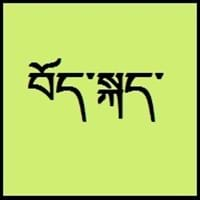Navajo vs Tibetan
Countries
United States of America
China, Nepal
National Language
United States of America
Nepal, Tibet
Second Language
Not spoken in any of the countries
Not spoken in any of the countries
Speaking Continents
North America
Asia
Minority Language
Not spoken in any of the countries
China, India, Nepal
Regulated By
Not Available
Committee for the Standardisation of the Tibetan Language
Interesting Facts
- Navajo language is tonal language, as it heavily relies on pitch to distinguish between similar words.
- Navajo ethinc group is 2nd largest Native American group.
- Tibetan dialects vary alot, so it's difficult for tibetans to understand each other if they are not from same area.
- Tibetan is tonal with six tones in all: short low, long low, high falling, low falling, short high, long high.
Similar To
Apache Language
Not Available
Derived From
Not Available
Not Available
Alphabets in
Navajo-Alphabets.jpg#200
Tibetan-Alphabets.jpg#200
Scripts
Latin
Tibetan alphabet, Tibetan Braille
Writing Direction
Not Available
Left-To-Right, Horizontal
Hello
Yá'át'ééh
བཀྲ་ཤིས་བདེ་ལེགས། (tashi delek)
Thank You
Ahéhee'
ཐུགས་རྗེ་ཆེ་། (tujay-chay)
How Are You?
Ąąʼ haʼíí baa naniná?
ཁྱེད་རང་སྐུ་གཇུགས་བདེ་པོ་ཡིན་པས།
(kayrang kusu debo yimbay?)
Good Night
Yá'át'ééh hiiłchi'į'
གཟིམ་ལཇག་གནང་དགོས་། (sim-jah nahng-go)
Good Evening
Yá'át'ééh ałní'íní
དགོང་དྲོ་བདེ་ལེགས།
Good Afternoon
Yá'át'ééh
ཉིན་གུང་བདེ་ལེགས།
Good Morning
Yá'át'ééh abíní
སྔ་དྲོ་བདེ་ལེགས། (nga-to delek)
Please
T'aa shoodi
thu-je zig / ku-chee.
Sorry
Not available
ཀོང་དགས་། (gawn-da)
Bye
Hágoónee’
ག་ལེར་ཕེབས་། (kha-leh phe)
I Love You
Ayóó ánííníshí
ང་ཁྱེད་རང་ལ་དགའ་པོ་ཡོད་ (nga kayrâng-la gawpo yö)
Excuse Me
Shoohá
དགོངས་དག བཟོད་དུ་གསོལ། ཐུགས་རྗེ་གཟིགས།
Dialect 1
Navajo1
Central Tibetan
Where They Speak
Arizona
China, India, Nepal
How Many People Speak
Not Available
Dialect 2
Navajo2
Khams Tibetan
Where They Speak
New Mexico
Bhutan, China
How Many People Speak
Not Available
Dialect 3
Navajo3
Amdo Tibetan
Where They Speak
Utah
China
How Many People Speak
Not Available
Speaking Population
Not Available
Not Available
Native Name
Diné Bizaad / Dinék'ehjí
བོད་སྐད་ (pö-gay)
Alternative Names
Navaho
Bhotia, Dbus, Dbusgtsang, Phoke, Tibetan, U, Wei, Weizang, Zang
French Name
navaho
tibétain
German Name
Navajo-Sprache
Tibetisch
Pronunciation
Not Available
Not Available
Ethnicity
Navajo people
tibetan people
Language Family
Dené–Yeniseian Family
Sino-Tibetan Family
Subgroup
Athapascan
Tibeto-Burman
Branch
Not Available
Not Available
Early Forms
No early forms
Old Tibetan, Classical Tibetan
Standard Forms
Navajo
Standard Tibetan
Signed Forms
Navajo Sign Language
Tibetan Sign Language
Scope
Individual
Not Available
ISO 639 6
Not Available
Not Available
Glottocode
nava1243
tibe1272
Linguasphere
No data available
No data Available
Language Type
Living
Not Available
Language Linguistic Typology
Subject-Object-Verb
Not Available
Language Morphological Typology
Fusional, Polysynthetic, Synthetic
Not Available
Navajo and Tibetan Language History
Comparison of Navajo vs Tibetan language history gives us differences between origin of Navajo and Tibetan language. History of Navajo language states that this language originated in 1500 CE whereas history of Tibetan language states that this language originated in c. 650. Family of the language also forms a part of history of that language. More on language families of these languages can be found out on Navajo and Tibetan Language History.
Navajo and Tibetan Greetings
People around the world use different languages to interact with each other. Even if we cannot communicate fluently in any language, it will always be beneficial to know about some of the common greetings or phrases from that language. This is where Navajo and Tibetan greetings helps you to understand basic phrases in Navajo and Tibetan language. Navajo word for "Hello" is Yá'át'ééh or Tibetan word for "Thank You" is ཐུགས་རྗེ་ཆེ་། (tujay-chay). Find more of such common Navajo Greetings and Tibetan Greetings. These greetings will help you to be more confident when conversing with natives that speak these languages.
Navajo vs Tibetan Difficulty
The Navajo vs Tibetan difficulty level basically depends on the number of Navajo Alphabets and Tibetan Alphabets. Also the number of vowels and consonants in the language plays an important role in deciding the difficulty level of that language. The important points to be considered when we compare Navajo and Tibetan are the origin, speaking countries, language family, different greetings, speaking population of these languages. Want to know in Navajo and Tibetan, which language is harder to learn? Time required to learn Navajo is 88 weeks while to learn Tibetan time required is 24 weeks.





